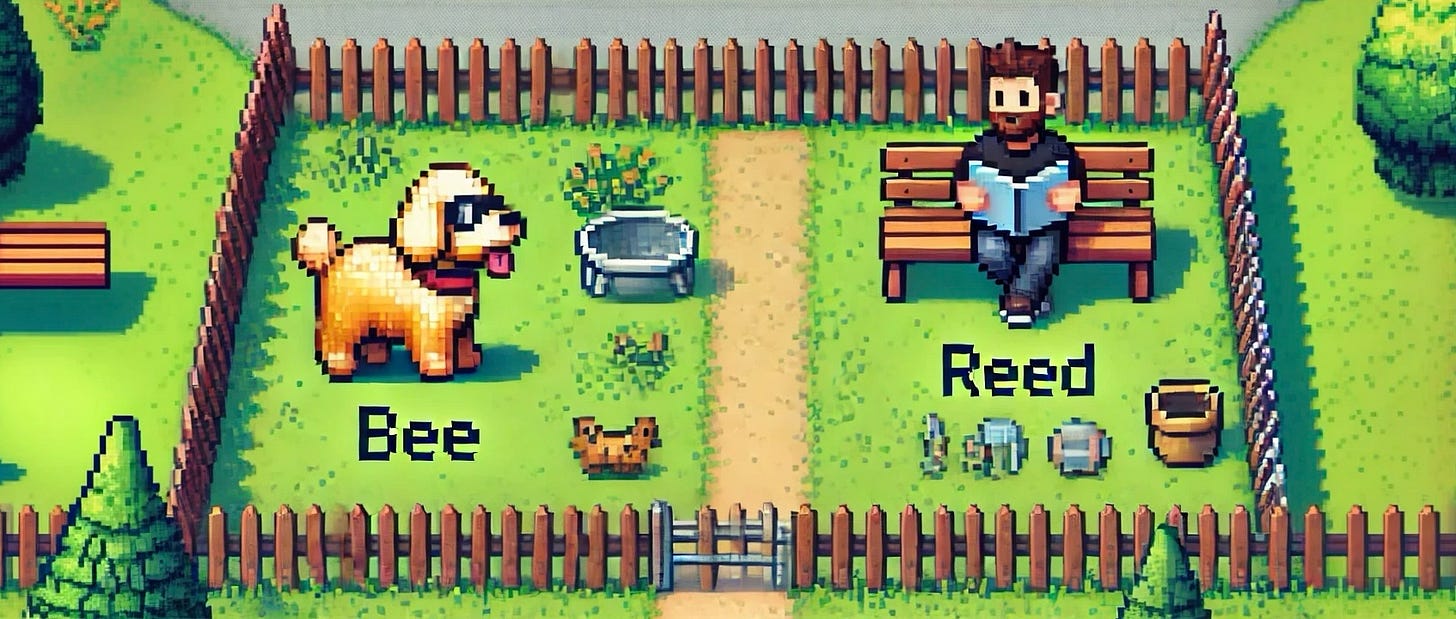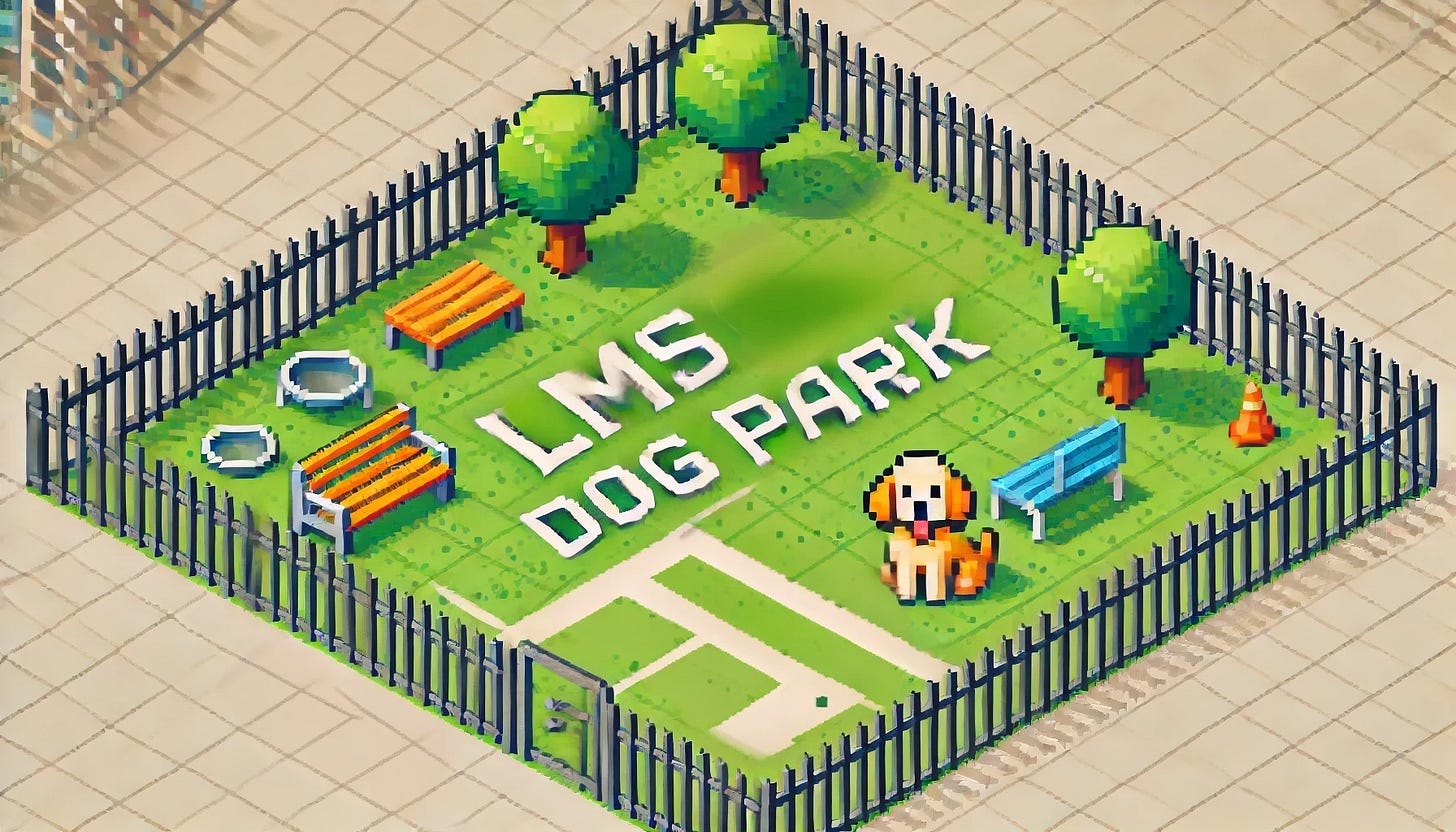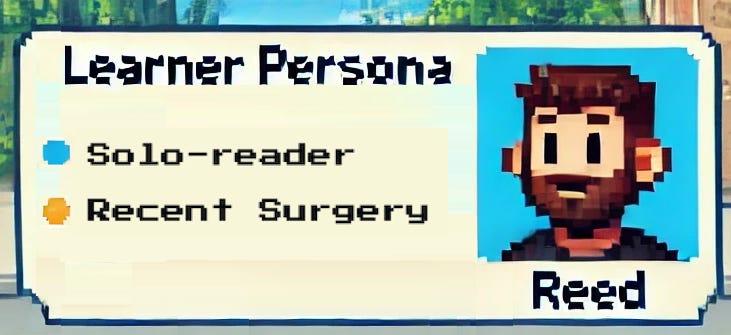From The Dog Park to The Classroom
Field Notes for Designers • 6 minute read
Continued From Part 1 of On Dog Parks & Online Social Spaces
Alone again, eyes closed, I let myself drift.
I fully unwind — upward and outward — as if my mind is predisposed to reach and keep reaching till it latches onto something larger? I am a tendril.
And for me, the nearest holdfast is almost always about our schools or our technologies — and how we design them. For whatever reason, they’ve become my lifetime obsession. So reach with me for a moment and let’s practice what the design firm IDEO refers to as “Analogous Inspiration.”1
The Dog Park as Analogous Inspiration
Imagine that on this glorious winter day, the space before us is not only an enormous dog park, but a kind of classroom. Bee and I, we are the students. And you are the teacher. And on this particular day, your students have vastly different needs.
Bee needs community. And I need a break from it.
We both need to be here — but we need this in very different ways.
In your head, you hear the phrase, “Different students, different needs.” But within the four walls of your classroom, how can you meet both?
And isn’t it something, how after all these years, that it’s still such a struggle to address this age-old problem?
Let’s leap again.
Into the Flat-Screened World
Imagine now that we’ve somehow slipped into yet another educational realm: the flat-screened world of the digital classroom. You, me, and of course Bee.
The same questions persist in this scenario. Will your two students find what they most need within this learning management system (LMS)? Will they even be able to find each other?
Surveys says, no.
That’s unfortunate. Will they at least be able to look themselves in the mirror somehow, or hear their own voice? Or will the roundness of their distinct personalities just be flattened into two dimensions?
When Home Means Alone
Imagine sweet Bee for a moment. He scans and he sniffs every edge and corner of what’s called the “course home.” Funny phrase, isn’t it? The course ‘home.’ You didn’t design it - but you do try to decorate it when time permits.
Perhaps this much is understood: that every landing page — be it a course home or a school’s global home — ought to reflect some idea of home?
So as for Bee, does he feel at home? Even if he’s alone? Even if there’s no other dogs to talk to on the other side of the digital fence?
Bee picks up a scent.
It’s a whole-class announcement replete with live links — so off Bee goes without looking back. You imagine, when Bee arrives, that he’ll find some glorious way to share his digital bark … or perhaps spray a canine version of “I was here, I was here!”
Bee isn’t gone long. But when he returns, he tilts his head to the side. He can’t find you, the educator, in real time. Nor me. We’re nowhere in sight.
He shrugs his little dog shoulders. This place is a ghost town. Are there no real-time dogs? This place just is not made for students like Bee.
When Asynchronous Means Without
And then of course, there is Reed, sitting over there by himself on what appears to be some kind of digital bench. He is absorbed in his own little personal reading moment. Or perhaps he’s logged in, but completely checked out? For all you know, he could just be happily lost in some Spotify playlist.
Whatever he’s doing, you hope he’s at least found a creative way to connect with his peers through some kind of back channel? It’s just so hard to know. Most back-channel tools are informal — and even when they actually are integrated into your school’s learning management system (LMS), even if there’s an instructor dashboard, it’s too hard to know if your students are truly connecting. Perhaps the integrations are just too basic? If only you, the educator, could get inside Reed’s head in real-time — right within these spaces that they still want to call “asynchronous.”
It’s an interesting word, isn’t it? Asynchronous? The origin seems pretty clear, but you can’t help yourself. You seek out the entry at the Online Etymology Dictionary and find the prefix A- followed by the word synchronous. The derivation seems clear. The prefix syn and the root Khronos would mean time together. So the word asynchronous means … without time together. It sure is pretty sobering when you look at it that way.
How strange, that we all could be in the same digital space at the very same time — yet no-one would know it? Why on earth would anyone want to preclude our ability to know who else is ‘present’ in real time?
But what can you do about product design? You’re only the teacher.
So you do what you can with what you’ve got. You focus on your students. You send out this survey with three open-ended questions: What’s been working, or not working, for you? What should I know about you? And, what do you most need to succeed?
You wait and you wait.
Disparate Needs & AI Dogs
Most of the class does not respond. But Reed and Bee do, lucky you. And these little surveys tell you a lot about your students!
So what works for Reed?
As for today, he’s happily alone in the most isolated corner of this digital dog park. He’s glad this isn’t a brick-and-mortar classroom — or he would’ve had to drop this class by now. No offense to in-person teachers. But the commute itself … is time and money that he doesn’t have. He’s a parent and works full-time. What’s working most for him is simply this: the online aspect.
What isn’t working for Reed? Well, most of the other dog park patrons.
No offense, but he’d rather not speak to anyone at all — only if he must — and only if it felt authentic and real. He doesn’t have space for any go-through-the-motions, perfunctory kind of obligations. Reed spends most of his day in meetings, so end of the day, he needs to recede. The small talk is rough. To make matters worse, he’s had some health challenges. He’s had an eye surgery, and it didn’t go well. And one thing he wants you to know: three of your PDFs didn’t work with his text-to-speech tools.
But overall, he’s relieved that he can now export most readings from the LMS directly as audio. That’s a game-changer.
He’s also glad that he finally figured out how to customize his phone’s triple-click feature to make it easier to read most websites with his ears. Incidentally, he’s also using voice-to-text to respond to today’s survey.
And the final question: what does Reed need?
Perhaps just a good, long moment to breathe, all by himself, without interruption. That is what helps him get immersed in the readings. He doesn’t need people, per se. Especially if they are using AI to fake the readings — and you can tell, he says, you can always tell. If they are genuine, great. But if not, it’s rough. Does he need to be social? He just needs a park bench, and an occasional, spontaneous chat with that one other student he already knows in the class named Bee. He’s only a tiny bit social, it would appear.
And as for Bee’s responses, he only responds to the question, what isn’t working?
What good is a digital bark, says Bee, when no digital dogs will come running? It just isn’t fun. Isn’t learning supposed to be fun?
As you read this, you have to wonder. What if there were some kind of AI dog2 that could run around in this digital space — in real time? A dog to run with, but also a dog that wouldn’t intrude unless you called.
Might a real-time AI dog in your LMS be better than nothing?
Continue Reading Part 3 of 3
See Analogous Inspiration at DesignKit.org by IDEO. As noted there, “Analogous Settings can help you isolate elements of an experience, interaction, or product, and then apply them to whatever design challenge you’re working on.”
AI dogs do exist. For more on what I call “Student-Side AI,” subscribe to Curious Tendril and check out the forthcoming essay for school leaders on equitable AI.







“Without time together” I’m pretty sure you just blew my mind. Anyone else here think they where just reading a sweet story about a guy in a dog park with his lonely dog and found themselves in moral conundrum about the need for presence for students in a digital school system serving siloed (asynchronous) learners who seek community in a remote artificial and intelligent world? Me neither. Onto pt 3. Buckling up.